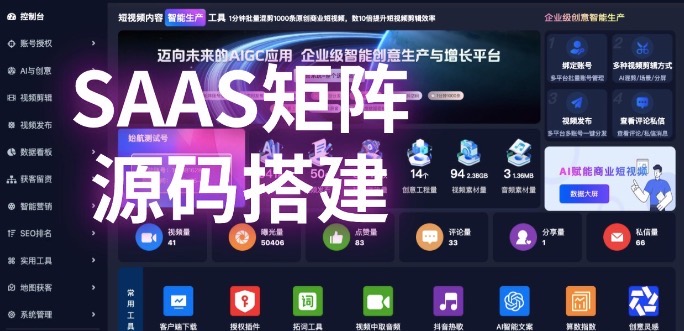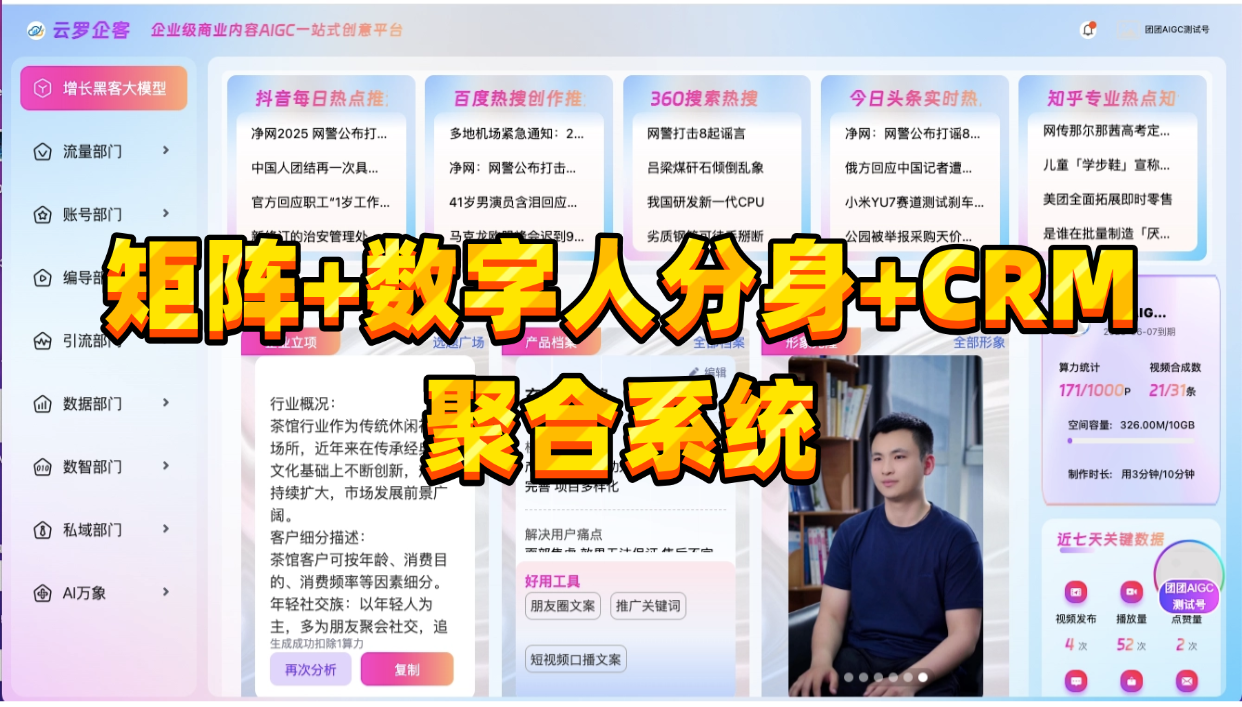什么是批量剪辑矩阵源码,支持OEM!
短视频批量剪辑矩阵源码并非 “单一剪辑工具的复制”,而是解决 **“多账号、多素材、多规则” 的自动化生产问题 **。其核心诉求可概括为三点:
- 素材原子化管理:将视频片段、字幕、贴纸等拆解为可复用组件;
- 剪辑规则模板化:支持按账号人设、平台规则配置剪辑逻辑;
- 生产流程自动化:从素材拼接、特效添加到格式适配全链路无感执行。

比如某本地生活矩阵需同时运营 10 个账号,美食号要 “3 秒菜品特写 + 数字人口播 + 店铺地址贴纸”,探店号要 “5 秒环境镜头 + 真人音效 + 团购链接挂载”—— 源码需通过模块化设计满足差异化需求,这也是与普通剪辑工具的核心区别。
二、核心技术栈选型:兼顾效率与兼容性
批量剪辑场景对处理速度、格式兼容性、稳定性要求极高,技术栈选型需精准匹配:
模块 | 主流技术选型 | 选型理由 |
视频处理核心 | FFmpeg + OpenCV | FFmpeg 适配 99% 音视频格式,OpenCV 支持图像特效 |
脚本解析 | Python (PyYAML) | 轻量易读,便于配置剪辑规则模板 |
任务调度 | Celery + Redis | 支持分布式任务队列,适配海量剪辑任务 |
存储层 | MinIO (对象存储) + MySQL | 高效存储视频素材,结构化管理剪辑模板 |
可视化交互 | Vue3 + Element Plus | 低代码配置界面,降低运营人员使用成本 |
下文以 “Python + FFmpeg” 技术栈为例,展示核心模块的源码实现。
三、核心模块源码实现:从基础到进阶
1. 基础模块:素材原子化管理系统
素材是批量剪辑的 “原材料”,需先实现素材的分类存储与快速检索。
(1)素材数据库设计(MySQL)
-- 素材表:存储视频/音频/图片素材元信息
CREATE TABLE `material` (
`id` bigint NOT NULL AUTO_INCREMENT COMMENT '素材ID',
`material_type` tinyint NOT NULL COMMENT '类型:1-视频 2-音频 3-图片 4-字幕',
`file_path` varchar(255) NOT NULL COMMENT '存储路径(MinIO地址)',
`duration` float DEFAULT NULL COMMENT '时长(视频/音频专用)',
`width` int DEFAULT NULL COMMENT '宽度(视频/图片专用)',
`height` int DEFAULT NULL COMMENT '高度(视频/图片专用)',
`tags` varchar(100) DEFAULT NULL COMMENT '标签(如“美食特写”“口播背景”)',
`create_time` datetime DEFAULT CURRENT_TIMESTAMP,
PRIMARY KEY (`id`),
INDEX `idx_tags` (`tags`) COMMENT '按标签检索素材'
) ENGINE=InnoDB DEFAULT CHARSET=utf8mb4 COMMENT='素材库表';
-- 剪辑模板表:关联素材与剪辑规则
CREATE TABLE `edit_template` (
`id` bigint NOT NULL AUTO_INCREMENT COMMENT '模板ID',
`template_name` varchar(50) NOT NULL COMMENT '模板名称(如“美食号通用模板”)',
`platform` tinyint NOT NULL COMMENT '适配平台:1-抖音 2-视频号 3-小红书',
`rule_config` text NOT NULL COMMENT '剪辑规则(YAML格式)',
`create_user` varchar(50) DEFAULT NULL,
PRIMARY KEY (`id`),
INDEX `idx_platform` (`platform`)
) ENGINE=InnoDB DEFAULT CHARSET=utf8mb4 COMMENT='剪辑模板表';
(2)素材上传与元信息提取(Python)
import os
import minio
import ffmpeg
import datetime
from pymysql import connect
from pydantic import BaseModel
from typing import Optional
# 1. MinIO客户端初始化
minio_client = minio.Minio(
endpoint="minio.example.com:9000",
access_key="minio_access_key",
secret_key="minio_secret_key",
secure=False
)
# 2. 素材元信息提取工具类
class MaterialMetaExtractor:
@staticmethod
def get_video_meta(file_path: str) -> dict:
"""提取视频素材元信息"""
try:
probe = ffmpeg.probe(file_path)
video_stream = next((stream for stream in probe['streams'] if stream['codec_type'] == 'video'), None)
audio_stream = next((stream for stream in probe['streams'] if stream['codec_type'] == 'audio'), None)
return {
"duration": float(probe['format']['duration']),
"width": int(video_stream['width']) if video_stream else None,
"height": int(video_stream['height']) if video_stream else None,
"audio_exists": 1 if audio_stream else 0
}
except Exception as e:
print(f"提取视频元信息失败:{e}")
return {}
@staticmethod
def get_audio_meta(file_path: str) -> dict:
"""提取音频素材元信息"""
try:
probe = ffmpeg.probe(file_path)
return {
"duration": float(probe['format']['duration']),
"sample_rate": probe['streams'][0]['sample_rate']
}
except Exception as e:
print(f"提取音频元信息失败:{e}")
return {}
# 3. 素材上传接口
def upload_material(local_file: str, material_type: int, tags: str) -> Optional[int]:
"""
上传素材到MinIO并写入数据库
:param local_file: 本地文件路径
:param material_type: 素材类型(1-视频 2-音频 3-图片 4-字幕)
:param tags: 标签,逗号分隔
:return: 素材ID
"""
# 生成存储路径
file_name = os.path.basename(local_file)
bucket_name = "video-material"
object_name = f"{material_type}/{datetime.datetime.now().strftime('%Y%m%d')}/{file_name}"
# 上传到MinIO
try:
minio_client.fput_object(
bucket_name=bucket_name,
object_name=object_name,
file_path=local_file
)
except Exception as e:
print(f"MinIO上传失败:{e}")
return None
# 提取元信息
meta_extractor = MaterialMetaExtractor()
if material_type == 1:
meta = meta_extractor.get_video_meta(local_file)
elif material_type == 2:
meta = meta_extractor.get_audio_meta(local_file)
else:
meta = {}
# 写入数据库
db_conn = connect(
host="mysql.example.com",
user="root",
password="db_password",
database="video_matrix"
)
try:
with db_conn.cursor() as cursor:
sql = """
INSERT INTO material (material_type, file_path, duration, width, height, tags)
VALUES (%s, %s, %s, %s, %s, %s)
"""
file_path = f"minio://{bucket_name}/{object_name}"
cursor.execute(sql, (
material_type, file_path, meta.get("duration"),
meta.get("width"), meta.get("height"), tags
))
db_conn.commit()
return cursor.lastrowid
except Exception as e:
db_conn.rollback()
print(f"数据库写入失败:{e}")
return None
finally:
db_conn.close()
# 测试:上传一段美食特写视频
if __name__ == "__main__":
material_id = upload_material(
local_file="./food_closeup.mp4",
material_type=1,
tags="美食特写,火锅,菜品"
)
print(f"上传成功,素材ID:{material_id}")
2. 核心模块:批量剪辑引擎实现
剪辑引擎是源码的 “心脏”,需支持按模板规则自动拼接素材、添加特效。以下实现 “3 秒特写 + 5 秒口播 + 2 秒贴纸” 的经典模板。
(1)剪辑规则配置(YAML 模板)
先定义可配置的剪辑规则,避免硬编码:
# 美食号抖音模板:rule_config字段内容
template_id: 1001
platform: 1 # 1-抖音
aspect_ratio: "9:16" # 竖屏
resolution: "1080x1920"
segments: # 剪辑片段配置
- segment_type: "video" # 视频片段
material_tag: "美食特写" # 按标签选素材
duration: 3 # 截取3秒
effects: # 特效
- type: "zoom" # 缩放特效
params: {"start_scale": 1.0, "end_scale": 1.2, "duration": 3}
- segment_type: "video" # 口播片段(数字人视频)
material_tag: "数字人口播"
duration: 5
audio_replace: True # 替换为专用口播音频
audio_tag: "火锅口播"
- segment_type: "image" # 贴纸片段
material_tag: "店铺地址"
duration: 2
position: {"x": 0.8, "y": 0.9} # 右下角
size: {"width": 0.2, "height": 0.1} # 占屏幕20%宽、10%高
output:
format: "mp4"
codec: "h264"
bitrate: "5M"
(2)剪辑引擎核心代码
import yaml
import ffmpeg
import random
from pymysql import connect
# 1. 素材检索工具
class MaterialRetriever:
@staticmethod
def get_material_by_tag(material_type: int, tag: str) -> Optional[str]:
"""按类型和标签随机获取素材路径"""
db_conn = connect(
host="mysql.example.com",
user="root",
password="db_password",
database="video_matrix"
)
try:
with db_conn.cursor() as cursor:
sql = """
SELECT file_path FROM material
WHERE material_type = %s AND tags LIKE %s
ORDER BY RAND() LIMIT 1
"""
cursor.execute(sql, (material_type, f"%{tag}%"))
result = cursor.fetchone()
return result[0] if result else None
finally:
db_conn.close()
# 2. 批量剪辑引擎
class BatchEditingEngine:
def __init__(self, template_id: int):
self.template = self._load_template(template_id)
self.retriever = MaterialRetriever()
self.temp_files = [] # 临时文件列表,用于后续清理
def _load_template(self, template_id: int) -> dict:
"""加载剪辑模板"""
db_conn = connect(
host="mysql.example.com",
user="root",
password="db_password",
database="video_matrix"
)
try:
with db_conn.cursor() as cursor:
sql = "SELECT rule_config FROM edit_template WHERE id = %s"
cursor.execute(sql, (template_id,))
result = cursor.fetchone()
return yaml.safe_load(result[0]) if result else {}
finally:
db_conn.close()
def _process_video_segment(self, segment: dict) -> str:
"""处理视频片段:选素材+加特效+截取时长"""
# 1. 获取素材
material_path = self.retriever.get_material_by_tag(
material_type=1, tag=segment["material_tag"]
)
if not material_path:
raise Exception(f"未找到标签为{segment['material_tag']}的视频素材")
# 2. 截取指定时长
temp_cut = f"./temp/cut_{random.randint(1000,9999)}.mp4"
self.temp_files.append(temp_cut)
ffmpeg.input(material_path).output(
temp_cut, t=segment["duration"], vcodec="copy", acodec="copy"
).run(overwrite_output=True)
# 3. 添加特效(以缩放为例)
effects = segment.get("effects", [])
current_input = temp_cut
for effect in effects:
if effect["type"] == "zoom":
temp_effect = f"./temp/effect_{random.randint(1000,9999)}.mp4"
self.temp_files.append(temp_effect)
# FFmpeg缩放滤镜:zoompan
zoom_filter = (
f"zoompan=z='if(lte(t,{effect['params']['duration']}),"
f"linenoise({effect['params']['start_scale']},{effect['params']['end_scale']}),1)':"
f"d={effect['params']['duration']}"
)
ffmpeg.input(current_input).filter(zoom_filter).output(
temp_effect, vcodec="h264", acodec="copy"
).run(overwrite_output=True)
current_input = temp_effect
# 4. 替换音频(若需要)
if segment.get("audio_replace"):
audio_path = self.retriever.get_material_by_tag(
material_type=2, tag=segment["audio_tag"]
)
if audio_path:
temp_audio = f"./temp/audio_{random.randint(1000,9999)}.mp4"
self.temp_files.append(temp_audio)
ffmpeg.concat(
ffmpeg.input(current_input).video,
ffmpeg.input(audio_path).audio,
v=1, a=1
).output(temp_audio).run(overwrite_output=True)
current_input = temp_audio
return current_input
def _process_image_segment(self, segment: dict) -> str:
"""处理图片片段:转视频+定位"""
# 1. 获取图片素材
material_path = self.retriever.get_material_by_tag(
material_type=3, tag=segment["material_tag"]
)
if not material_path:
raise Exception(f"未找到标签为{segment['material_tag']}的图片素材")
# 2. 图片转视频(添加时长)
temp_video = f"./temp/image_{random.randint(1000,9999)}.mp4"
self.temp_files.append(temp_video)
ffmpeg.input(
material_path, loop=1, t=segment["duration"], framerate=30
).output(temp_video, vcodec="h264").run(overwrite_output=True)
# 3. 调整位置和大小
position = segment["position"]
size = segment["size"]
temp_position = f"./temp/position_{random.randint(1000,9999)}.mp4"
self.temp_files.append(temp_position)
# FFmpeg水印滤镜:overlay
overlay_filter = (
f"overlay=W*{position['x']}-w*{position['x']}*2:"
f"H*{position['y']}-h*{position['y']}*2,"
f"scale=W*{size['width']}:H*{size['height']}"
)
# 先创建黑色背景,再叠加图片
bg_size = self.template["resolution"].split("x")
ffmpeg.input(
"color=black", format="lavfi", t=segment["duration"],
s=f"{bg_size[0]}x{bg_size[1]}"
).overlay(
ffmpeg.input(temp_video).filter("scale", overlay_filter.split(",")[1]),
filter_complex=overlay_filter.split(",")[0]
).output(temp_position, vcodec="h264").run(overwrite_output=True)
return temp_position
def generate_video(self, output_path: str) -> bool:
"""生成最终视频"""
try:
# 1. 创建临时目录
os.makedirs("./temp", exist_ok=True)
# 2. 处理所有片段
segments = self.template["segments"]
processed_segments = []
for seg in segments:
if seg["segment_type"] == "video":
processed = self._process_video_segment(seg)
elif seg["segment_type"] == "image":
processed = self._process_image_segment(seg)
else:
continue
processed_se</doubaocanvas>

